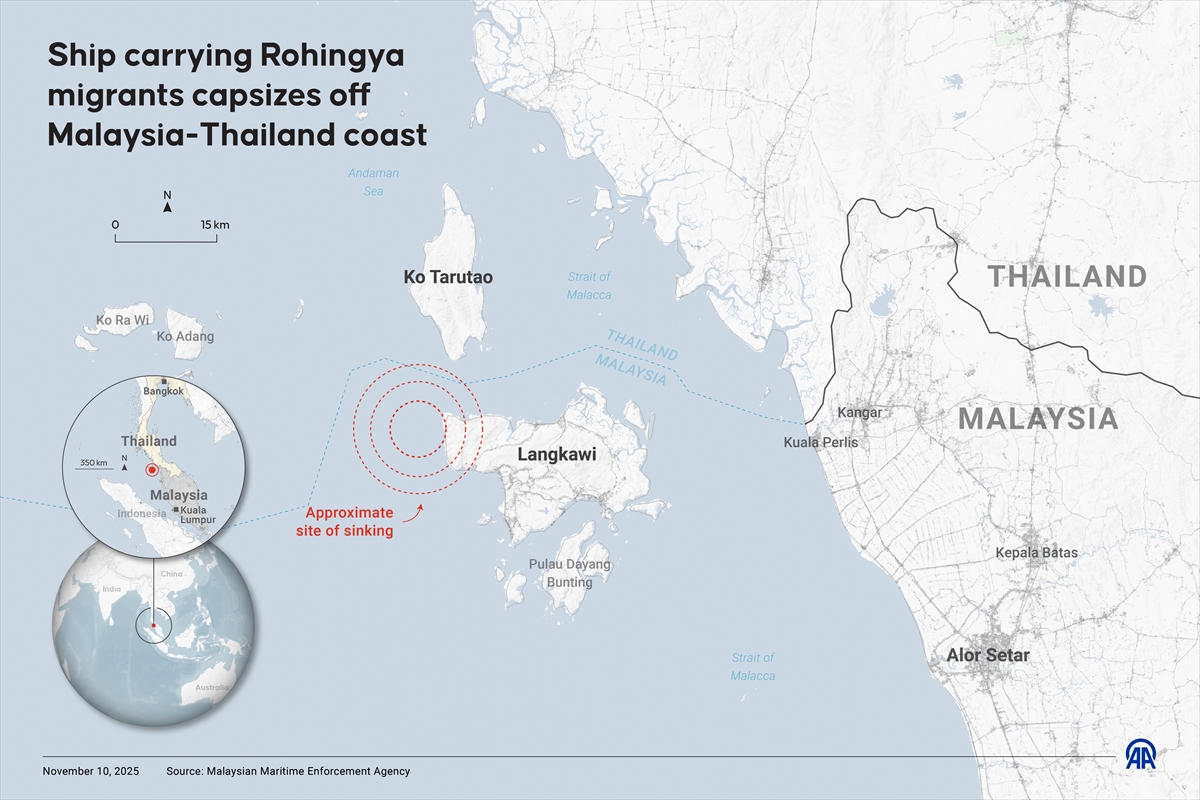
By Elham Asaad Buaras
A desperate search-and-rescue operation entered its third day on November 11, as authorities recovered more bodies from a capsized boat carrying Rohingya Muslim refugees. The tragedy, which has already claimed at least 21 lives and left hundreds more missing in a vast and unforgiving sea, underscores the escalating desperation of a people forced to choose between perilous escape and continued persecution in Myanmar. With each passing hour, hope diminishes, highlighting the grim calculus confronting the Rohingya: risk a hazardous sea voyage or remain trapped in a cycle of statelessness and violence.
Malaysian and Thai officials confirmed the toll as they scoured waters near the maritime border over the weekend. The vessel, believed to carry roughly 70 undocumented migrants, capsized near Thailand’s Ko Tarutao island, north of Malaysia’s Langkawi Island. The Malaysian Coast Guard reported that 13 people have been rescued, yet dozens aboard the capsized boat remain unaccounted for. Authorities also warned that a second boat carrying an estimated 230 people is missing, raising fears that the final death toll could be far higher.
According to Malaysian police, the ill-fated journey began in mid-October from Myanmar’s Rakhine State. Around 300 Rohingya migrants initially boarded a large vessel bound for Malaysia. In a hazardous attempt to evade authorities, passengers were transferred onto at least two smaller, overcrowded boats on November 6. One of these smaller boats, described as cramped and lacking basic necessities such as fresh water, capsized shortly thereafter. It was discovered drifting in Thai waters on November 8, triggering the ongoing multinational search operation.
Malaysia’s Kedah police chief, Adzli Abu Shah, confirmed that survivors include Rohingya and Bangladeshi men. Among the recovered victims are a Rohingya woman and at least one child, illustrating the familial nature of these perilous journeys.
The Malaysian Maritime Enforcement Agency (MMEA), in coordination with Thai authorities, launched an operation covering over 250 square nautical miles. Maritime First Admiral Romli Mustafa, MMEA director for Kedah and Perlis, stated the search is expected to continue for seven days. He noted that strong currents are drifting victims toward Malaysian waters: “We expect to discover more victims today, as sea current patterns in the search area indicate that they are drifting towards Malaysian waters,” Mustafa told reporters on November 10.
Authorities have also pointed to human trafficking networks as a central factor in the disaster. First Admiral Romli warned that “cross-border syndicates are now increasingly active in exploiting migrants,” charging up to $3,500 per person for the dangerous passage.
The incident underscores the profound and ongoing crisis facing the Rohingya people. A Muslim ethnic minority from Myanmar, they are denied citizenship under the 1982 Myanmar Citizenship Law, rendering them the world’s largest stateless population. Decades of systematic discrimination and violence have compounded their plight.
A military crackdown in August 2017, described by the United Nations as bearing the “hallmarks of genocide,” forced more than 742,000 Rohingya to flee into Bangladesh. Today, over one million reside in overcrowded and squalid camps in Cox’s Bazar. Since Myanmar’s 2021 military coup, violence and instability have worsened, displacing millions more internally and exacerbating already intolerable conditions in the camps.
“People are dying in the fighting, dying from hunger. So, some think it’s better to die at sea than to die slowly here,” a Rohingya refugee in Cox’s Bazar told reporters, capturing the desperation driving these journeys.
The scale of these hazardous voyages is alarming. According to UNHCR, over 5,100 Rohingya boarded boats from Myanmar and Bangladesh between January and early November 2025. Nearly 600 have been reported dead or missing—roughly one fatality or disappearance for every eight who attempt the journey.
Routes to Malaysia and Indonesia rank among the world’s deadliest. Malaysia, a Muslim-majority country, has historically been a preferred destination, but recent policy measures have sought to limit arrivals. In January 2025, Malaysian authorities turned away two boats carrying nearly 300 Rohingya refugees after providing them with food and water.
Human rights organisations have repeatedly called for stronger regional action. Amnesty International said the recent capsizing “once again lays bare the deadly risks faced by Rohingya Muslims,” urging governments to intensify search-and-rescue efforts and address the root causes of the crisis.
[Photo: An infographic titled “Ship carrying Rohingya migrants capsizes off Malaysia-Thailand coast” created in Ankara, Turkiye on November 10, 2025. Photojournalist: Mehmet Yaren Bozğun/AA]